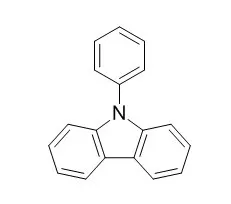| Structure Identification: |
| Org Biomol Chem. 2012 Dec 21;10(47):9481-90. | | Starburst dendrimers consisting of triphenylamine core and 9-phenylcarbazole-based dendrons: synthesis and properties.[Pubmed: 23117896 ] | .Novel dendrimers consisting of a triphenylamine core and 1st to 3rd generations of 9-Phenylcarbazole-based dendrons were synthesized by Suzuki coupling reaction through convergent approach.
METHODS AND RESULTS:
Their structures were confirmed by two-dimensional correlated H-H COSY and C-H HSQC NMR spectra, MALDI-TOF MS and elemental analysis. The dendrimers exhibit excellent thermal stability with 5% weight loss temperatures over 540 °C. The computer modeling reveals that the dendrons in dendrimers greatly twisted with the generation, leading to the dendrimers decreased crystalline ability. Of interest is the observation that, for an identical dendrimer, the solid film displays the similar UV absorption and luminescence emission profiles to the solution sample, indicating that, after evaporation of solvent, the rigid dendrimer can well maintain its conformational morphology and the aggregation or stacking of the chromophoric groups is significantly inhibited. All the dendrimers can emit intense fluorescence with narrow full width at half maximum (FWHM) around 46-50 nm. Moreover, with the incremental generation, the quantum efficiencies remarkably increase from 64 to 95%, suggesting that the highly contorted and bulky dendrons effectively decrease energy wastage and non-radiative decay.
CONCLUSIONS:
The synergistic effect of electron-donating triphenylamine core and 9-Phenylcarbazole-based dendrons results in the HOMO energy level of -5.36 eV for the 3rd-generation dendrimer, very close to the work function of the ITO/PEDOT electrode (-5.2 eV), which characteristic is very advantageous for the hole injection and transport materials. | | J Org Chem. 2000 Jan 14;65(1):116-23. | | Synthesis and characterization of monodendrons based on 9-phenylcarbazole[Pubmed: 10813904] |
METHODS AND RESULTS:
A series of 9-Phenylcarbazole ethynylene monodenrons have been prepared by palladium-catalyzed coupling reactions creating well-organized arrays of redox centers. The tert-butyl groups attached to the 3,6-positions of peripheral 9-Phenylcarbazole monomers provide adequate solubility to a limited degree. Trimer and 7-mer monodendrons were prepared using a monomer with 3, 3-diethyltriazene at its focal point. To facilitate purification, the synthesis of 15-mer monodendron, however, required a monomer bearing a 3-hydroxy-3-methyl-but-1-ynyl group at its focal point as a masking group for the terminal acetylene functionality. Although the solubility was limited, high generation monodendrons were found to be readily soluble in carbon disulfide, a solvent of high polarizability.
CONCLUSIONS:
Spectroscopic studies showed that there is limited through-bond conjugation over the monodendrons, but fluorescence studies suggested the presence of long-range through-space interactions in the higher members of the series. | | Org Lett. 2007 Oct 25;9(22):4531-4. | | Synthesis and properties of dumbbell-shaped dendrimers containing 9-phenylcarbazole dendrons.[Pubmed: 17900196] | | We report the synthesis and structural characterization of two dumbbell-shaped dendrimers incorporating 9-Phenylcarbazole units as dendrons, as well as their thermal, morphological, photophysical, and electrochemical properties. |
|






 Cell. 2018 Jan 11;172(1-2):249-261.e12. doi: 10.1016/j.cell.2017.12.019.IF=36.216(2019)
Cell. 2018 Jan 11;172(1-2):249-261.e12. doi: 10.1016/j.cell.2017.12.019.IF=36.216(2019) Cell Metab. 2020 Mar 3;31(3):534-548.e5. doi: 10.1016/j.cmet.2020.01.002.IF=22.415(2019)
Cell Metab. 2020 Mar 3;31(3):534-548.e5. doi: 10.1016/j.cmet.2020.01.002.IF=22.415(2019) Mol Cell. 2017 Nov 16;68(4):673-685.e6. doi: 10.1016/j.molcel.2017.10.022.IF=14.548(2019)
Mol Cell. 2017 Nov 16;68(4):673-685.e6. doi: 10.1016/j.molcel.2017.10.022.IF=14.548(2019)